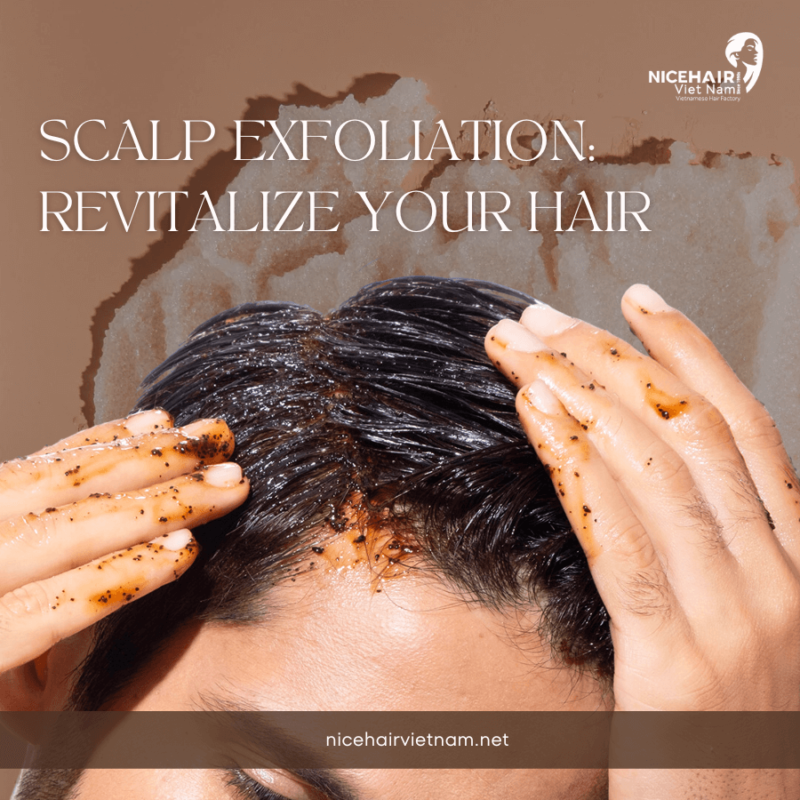Are you looking for a way to improve the health of your hair and scalp? Scalp exfoliation is a beneficial practice that can help you achieve just that. By gently removing dead skin cells, excess oil, and product buildup from your scalp, exfoliation promotes a clean and rejuvenated scalp environment. In this article, we will explore the importance of scalp exfoliation and provide you with step-by-step guidelines on how to effectively exfoliate your scalp. Get ready to revitalize your hair and promote a healthy scalp!
What is scalp exfoliation?
Scalp exfoliation is the process of removing dead skin cells, excess oil, and product buildup from the scalp. It can be done using physical or chemical exfoliants.
Physical exfoliation involves scrubbing the scalp with a brush or massaging it with abrasive products such as sea salt, sugar, or beads. Chemical exfoliation involves using products that contain active ingredients like AHAs and BHAs to dissolve dead skin cells and unclog hair follicles. Scalp exfoliation can help to promote hair growth, remove dandruff, and keep the scalp healthy and moisturized. It is recommended to exfoliate the scalp on wet, just-shampooed hair and to choose products that are gentle and suitable for your hair type. Anyone can exfoliate their scalp, but it may be especially beneficial for those with dandruff, dry skin, or oily hair. However, scalp exfoliation may not be suitable for everyone, as it can be harsh and cause dryness or irritation.
Benefits of scalp exfoliation
Scalp exfoliation is an essential practice for maintaining a healthy scalp and promoting optimal hair growth. It involves the removal of dead skin cells, excess oil, and product buildup from the scalp, creating a clean and revitalized environment. This process is crucial because:
- Promotes hair growth: By unclogging hair follicles and removing debris, scalp exfoliation enhances blood circulation to the hair roots, promoting healthy hair growth.
- Removes product buildup: Over time, hair care products, oils, and environmental pollutants can accumulate on the scalp, leading to product buildup. Exfoliating the scalp helps remove these residues, allowing the hair to breathe and preventing dullness.
- Prevents dandruff and dryness: Dead skin cells can accumulate on the scalp, causing flakiness and dandruff. Regular exfoliation helps to eliminate these cells, reducing dandruff and preventing dryness.
- Enhances product absorption: A clean and exfoliate scalp is better able to absorb the beneficial ingredients from hair care products, maximizing their effectiveness and results.
- Improves scalp health: Scalp exfoliation maintains a balanced scalp environment, reducing itchiness, minimizing scalp irritation, and promoting overall scalp health.
By incorporating scalp exfoliation into your hair care routine, you can enjoy numerous benefits, including healthier hair, reduced dandruff, improved scalp condition, and enhanced product absorption.
Different types of scalp exfoliation
There are two main types of scalp exfoliation: physical and chemical.
Physical exfoliation involves scrubbing the scalp with a brush or massaging it with abrasive products such as sea salt, sugar, or beads. This method is recommended for people with thick hair and lots of buildup. Physical exfoliants contain grainy ingredients, such as salt or sugar, and help scrub away buildup. Scalp scrubs and scalp brushes are examples of physical exfoliants.
Chemical exfoliation involves using products that contain active ingredients like AHAs and BHAs to dissolve dead skin cells and unclog hair follicles. This method is a better choice for those with fine hair and sensitive skin. Chemical exfoliants can be more gentle than physical exfoliants and help break down the skin cells buildup. There are a range of chemical exfoliants, the two most common being AHAs and BHAs. It is important to choose the right type of exfoliation for your hair type and to exfoliate the scalp before shampooing.
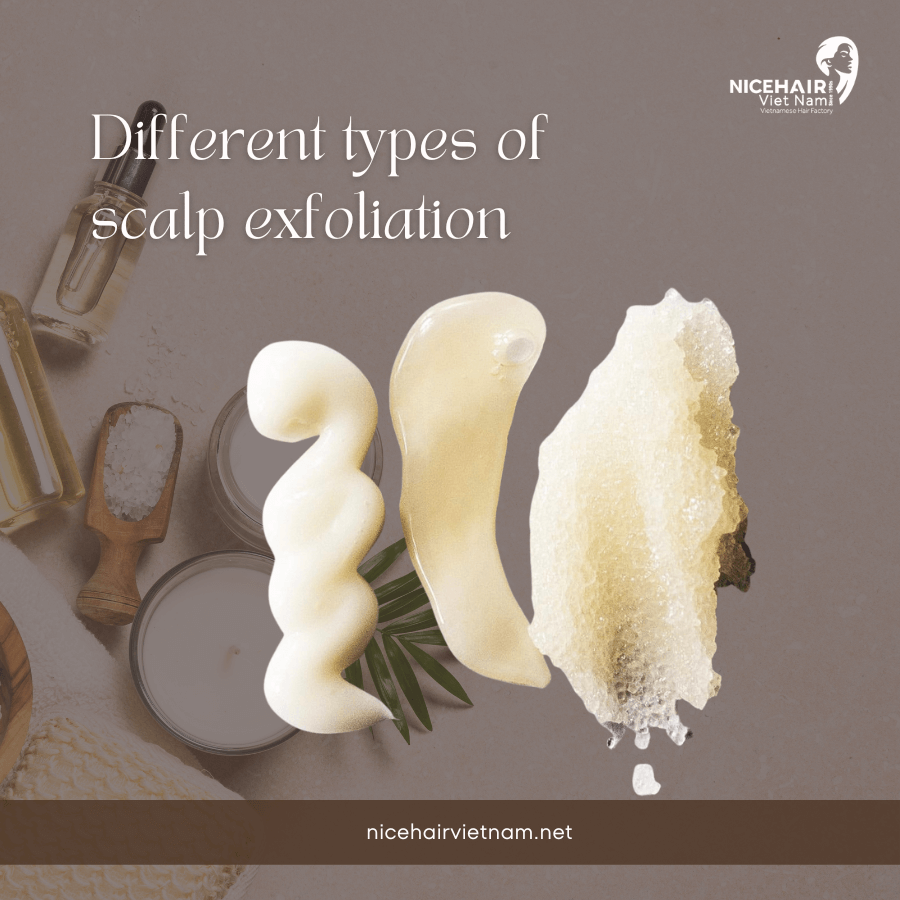
Common chemical exfoliants used in scalp care products
Some common chemical exfoliants used in scalp care products include:
- Alpha-Hydroxy Acids (AHAs): AHAs such as glycolic acid and lactic acid are commonly used in scalp exfoliants. They help to dissolve dead skin cells and unclog hair follicles without causing irritation.
- Beta-Hydroxy Acids (BHAs): BHAs like salicylic acid are effective in exfoliating the scalp. They penetrate the pores and help to remove excess oil and debris, making them particularly beneficial for oily scalps and those prone to dandruff.
- Charcoal: Charcoal is a popular ingredient in scalp exfoliants due to its ability to draw out impurities and excess oil from the scalp. It provides a deep cleanse and helps to detoxify the scalp.
- Apple cider vinegar: Apple cider vinegar is known for its antimicrobial properties and can help balance the pH of the scalp. It can also help remove buildup and soothe irritation.
- Tea tree oil: Tea tree oil has antifungal and antibacterial properties, making it a common ingredient in scalp exfoliants. It can help combat dandruff, soothe itchiness, and promote a healthy scalp.
- Salicylic Acid: Salicylic acid is a keratolytic agent that helps to remove dead skin cells and unclog hair follicles. It is often used in scalp exfoliants for its exfoliating and anti-inflammatory properties.
These chemical exfoliants work to gently remove dead skin cells, unclog hair follicles, and promote a healthier scalp. It’s important to follow the instructions on the product and perform a patch test before using them to ensure they are suitable for your scalp and do not cause any adverse reactions.
Frequency of use of chemical exfoliants on the scalp
According to hair experts, most chemical exfoliants should be used once a week or every other week. Chemical exfoliants work by using active ingredients like AHAs and BHAs to dissolve buildup on the scalp. They tend to be more gentle on the scalp compared to physical exfoliants, as you only need to apply the product to your scalp and let it sit for 5-10 minutes before rinsing out. Over-exfoliating can cause dryness, irritation, and even extra oil production, so it’s important to follow the recommended usage frequency. If you have very oily hair with a lot of dandruff, you can use chemical exfoliants up to twice a week, but for others, once a week is sufficient. However, the frequency of scalp exfoliation also depends on your hair type and how much styling product you use. If you’re experiencing dryness, flakes, or irritation even after exfoliating once a week, you may want to consider a more gentle approach and switch to a moisturizing shampoo and conditioner.
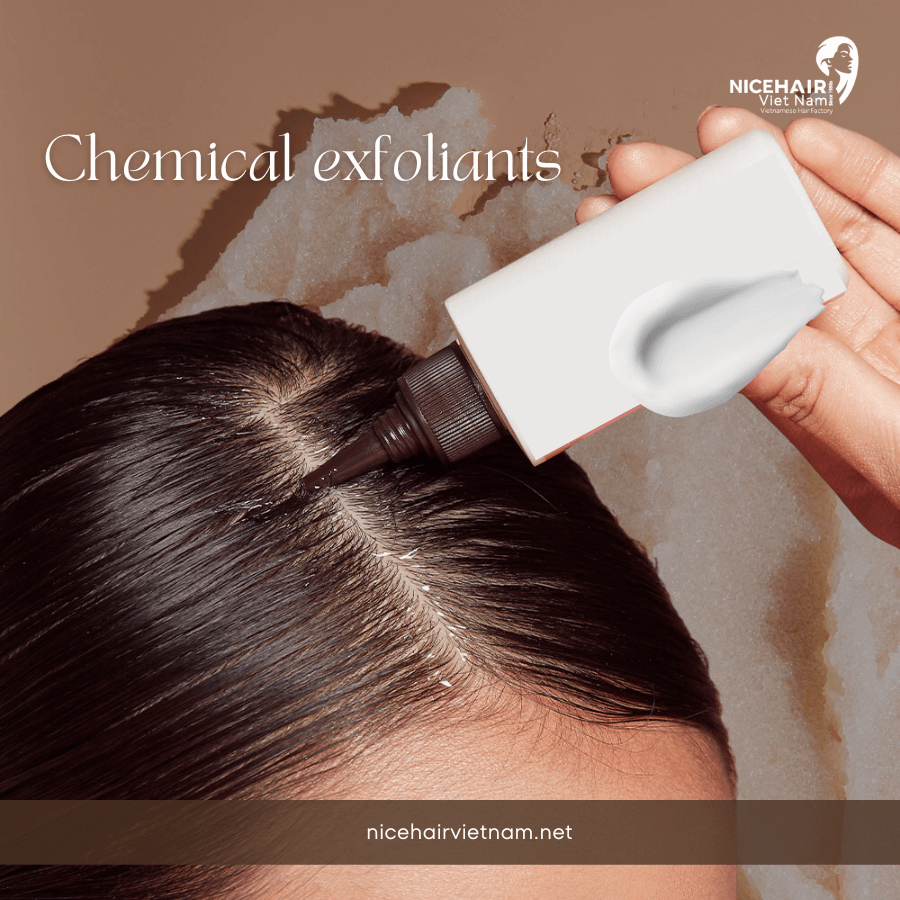
Considerations of using chemical exfoliants on the scalp
Using chemical exfoliants on the scalp can have potential side effects, especially if not used properly or if you have a sensitive scalp. Some potential side effects include:
- Irritation: Chemical exfoliants can cause scalp irritation, redness, or itching, especially if you have a sensitive scalp. It’s important to follow the instructions on the product and not leave it on for longer than recommended.
- Dryness: Overuse or improper use of chemical exfoliants can lead to dryness on the scalp. This can cause flakiness and discomfort. It’s important to moisturize the scalp after exfoliation to maintain its hydration.
- Allergic reactions: Some individuals may have allergic reactions to certain chemical exfoliants. If you experience any signs of an allergic reaction, such as swelling, rash, or difficulty breathing, discontinue use immediately and seek medical attention.
- Sensitivity: Using chemical exfoliants too frequently or using products with high concentrations of active ingredients can make the scalp more sensitive over time. It’s important to find a balance and not over-exfoliate the scalp.
To minimize the risk of side effects, it’s recommended to perform a patch test before using a new product and to start with a lower concentration of active ingredients. It’s also important to choose products specifically formulated for the scalp and to follow the recommended usage frequency. If you have any concerns or experience persistent discomfort, it’s best to consult with a dermatologist or healthcare professional.
Understanding physical scalp exfoliation
Physical scalp exfoliation refers to the process of physically removing dead skin cells, excess oil, and product buildup from the scalp using mechanical methods. It involves the use of tools or products that provide a physical exfoliating action to promote a clean and rejuvenated scalp.
During physical scalp exfoliation, gentle pressure is applied to the scalp using various techniques or tools. This can include using scalp brushes, scalp massagers, or scalp scrub products with granules or particles designed to scrub away impurities.
The exfoliating action helps to loosen and slough off dead skin cells, unclog hair follicles, and remove any buildup or debris that may be present on the scalp. By physically stimulating the scalp, it can promote blood circulation, improve nutrient delivery to the hair follicles, and create a healthy environment for optimal hair growth.
Scalp scrubs
What are scalp scrubs?
Scalp scrubs often contain gentle exfoliating ingredients like sugar, salt, jojoba beads, or other natural exfoliants. Some scalp scrubs also incorporate additional ingredients that offer nourishing and soothing properties to the scalp.
When using a physical scalp scrub, you apply it directly to the scalp and gently massage it in circular motions. The scrub particles help to loosen and slough off impurities, promoting a clean and refreshed scalp.
One of the advantages of a physical scalp scrub is that it offers immediate tactile feedback, allowing you to feel the exfoliating action and ensure thorough coverage on the scalp. It can provide a satisfying sensation and contribute to a refreshing and invigorating scalp cleansing experience.
However, it’s important to note that physical scalp scrubs should be used with care and moderation. The abrasiveness of the particles can vary, and excessive or aggressive scrubbing can potentially irritate the scalp or cause damage. It’s recommended to follow the instructions provided with the specific product and be gentle during application to avoid any potential negative effects.
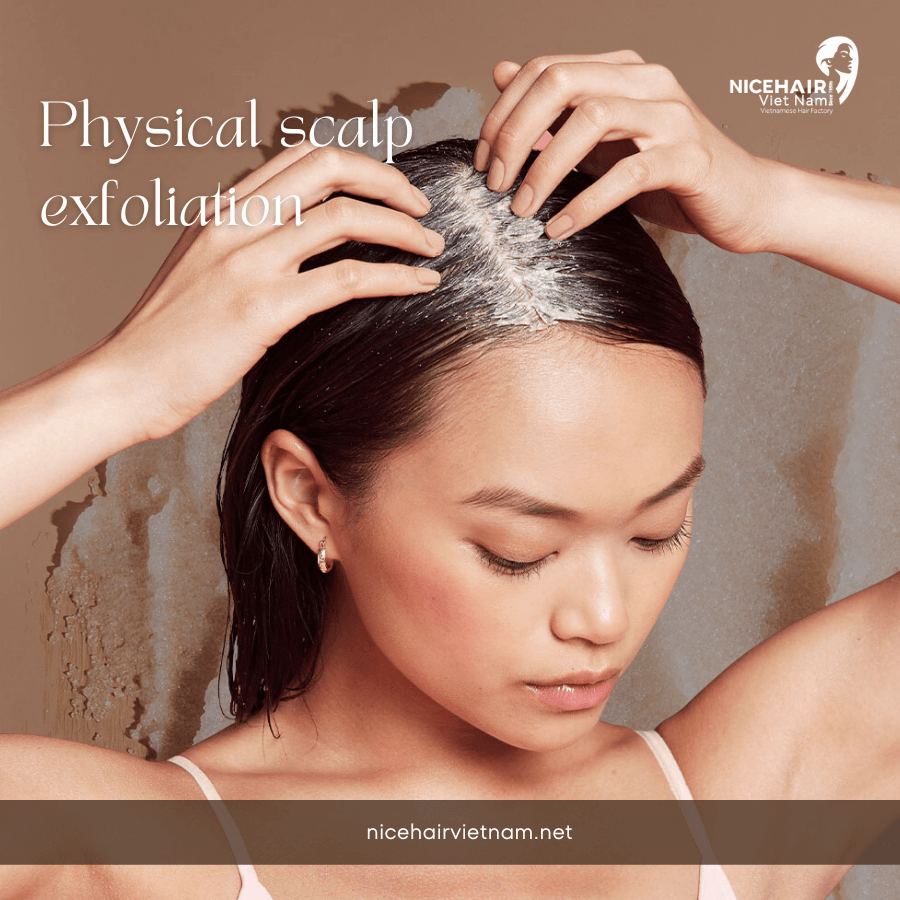
Natural ingredients that can be used for physical scalp exfoliation
Here are some natural ingredients that can be used for physical scalp exfoliation:
- Brown sugar and oats: A combination of brown sugar and oats can work as a great scalp scrub, especially for those with dry hair. It helps to moisturize the scalp and remove excess oils and build-up.
- Coconut oil and sea salt: Mixing coconut oil with sea salt creates a natural scalp exfoliator. The sea salt acts as an abrasive to remove dead skin cells and the coconut oil helps to moisturize the scalp.
- Coffee and coconut/olive oil: Coffee grounds mixed with coconut or olive oil can create an effective scalp scrub. The coffee grounds provide gentle exfoliation while the oil helps to nourish the scalp.
- Baking soda, shampoo, and tea tree oil: Baking soda can be combined with shampoo and a few drops of tea tree oil to create a scalp exfoliating mixture. Baking soda helps to remove build-up and tea tree oil has antimicrobial properties that can help with scalp health.
- Lemon juice, sea salt, and olive oil: Mixing lemon juice, sea salt, and olive oil can create a natural scalp exfoliator. Lemon juice helps to remove dead skin cells, sea salt provides exfoliation, and olive oil moisturizes the scalp.
These natural ingredients can be easily found at home and can be used to create effective scalp exfoliators. It’s important to choose ingredients that are suitable for your hair type and to perform a patch test before applying them to your scalp. When using these ingredients for scalp exfoliation, it’s important to mix them with other gentle ingredients and perform a patch test before applying them to the entire scalp. This will help ensure that they are well-tolerated and do not cause any adverse reactions.
Frequency of scalp exfoliation by natural ingredient
The frequency of scalp exfoliation using natural ingredients depends on your hair type, scalp condition, and the specific ingredients you choose. Here are some general guidelines:
- Sugar and olive oil scrub: A sugar and olive oil scrub is a gentle option for scalp exfoliation. It can be used once a week or every two weeks, depending on your scalp’s sensitivity. Adjust the frequency based on how your scalp responds.
- Baking soda paste: Baking soda is known for its clarifying properties. However, it can be harsh on the scalp if used too frequently. It’s recommended to use a baking soda paste as a scalp exfoliant once every two weeks or even once a month to prevent over-exfoliation.
- Apple cider vinegar rinse: Apple cider vinegar is often used as a final rinse after exfoliating the scalp. It helps balance the pH level of the scalp. You can incorporate an apple cider vinegar rinse into your hair care routine once a week or every two weeks.
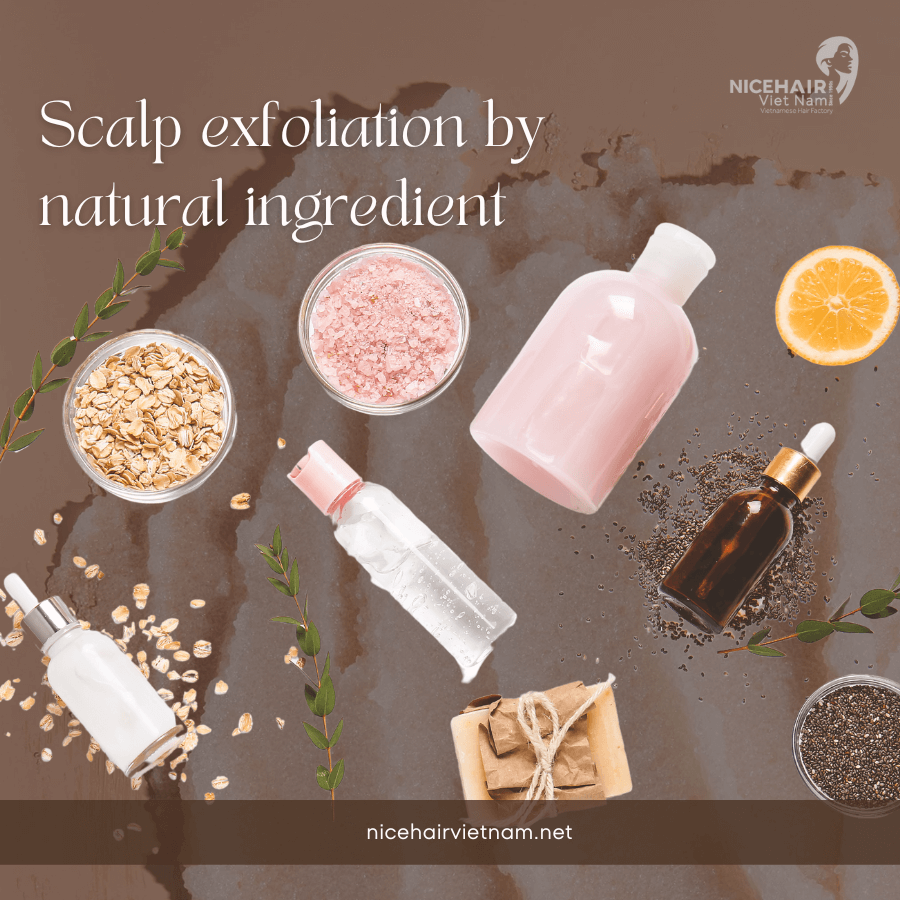
Properly apply a scalp scrub for maximum benefits
It’s important to note that the frequency of using a scalp scrub will depend on your hair type and the specific product you’re using. Generally, once a week or every other week is recommended. However, it’s best to follow the instructions provided by the product manufacturer for the optimal usage frequency. To properly apply a scalp scrub for maximum benefits, follow these steps:
- Choose the right scalp scrub: Select a scalp scrub that suits your hair type and scalp condition. Look for products with gentle exfoliating agents such as sugar, salt, or jojoba beads. Avoid scrubs with harsh ingredients that may cause irritation.
- Wet your hair: Start by wetting your hair thoroughly in the shower. This helps to soften the scalp and prepare it for exfoliation.
- Section your hair: Divide your hair into manageable sections using hair clips or hair ties. This allows for easier application and ensures that the scrub is evenly distributed.
- Apply the scalp scrub: Take a small amount of the scrub and apply it directly to your scalp. Begin with the sections where you have more buildup or dryness. Use your fingertips to gently massage the scrub into your scalp in circular motions. Focus on the areas near the hairline, the crown, and the nape of the neck.
- Massage the scalp: After applying the scrub, use your fingertips to massage your scalp gently. The massaging action improves blood circulation, helps dislodge impurities, and enhances the exfoliation process. Take your time and be gentle to avoid causing any discomfort or irritation.
- Leave it on (optional): Depending on the instructions provided with your specific scalp scrub, you may choose to leave it on for a few minutes to allow the beneficial ingredients to penetrate the scalp. This step can further enhance the effectiveness of the scrub.
- Rinse thoroughly: Rinse your hair and scalp with lukewarm water, ensuring that all traces of the scrub are removed. Make sure to rinse thoroughly to prevent any residue from remaining on the scalp.
- Follow with shampoo and conditioner: After rinsing out the scrub, follow up with a gentle, sulfate-free shampoo to cleanse your hair and scalp. Massage the shampoo into your hair and scalp, focusing on the roots. Rinse thoroughly and follow with a nourishing conditioner to moisturize and restore balance to your hair and scalp.
- Finish with a cool water rinse: For an extra boost of scalp stimulation and to help close the hair cuticles, finish your hair wash routine with a cool water rinse. This can leave your hair looking shiny and your scalp feeling refreshed.
By following these steps, you can properly apply a scalp scrub, maximize its benefits, and achieve a clean, rejuvenated scalp for healthier and more vibrant hair.
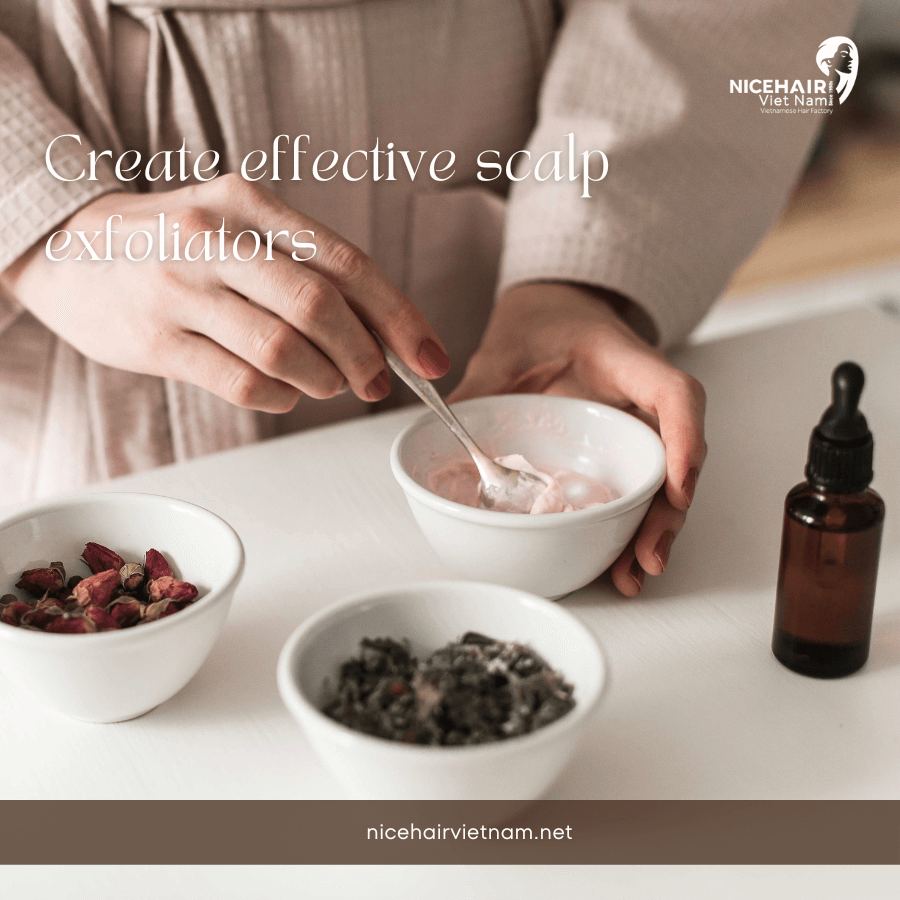
Best practices for scalp exfoliation
When it comes to scalp exfoliation, there are some best practices to keep in mind to ensure a safe and effective experience. Follow these guidelines for the best results:
- Be gentle: The scalp is sensitive, so it’s crucial to be gentle during exfoliation. Avoid applying excessive pressure or scratching your scalp aggressively. Use your fingertips to massage the scrub in gentle circular motions.
- Moisturize afterwards: After exfoliating, it’s important to replenish moisture in your hair and scalp. Follow up with a nourishing conditioner or hair mask to hydrate and restore balance. This helps to prevent dryness and keeps your scalp healthy.
- Protect your scalp: Shield your scalp from the sun’s harmful rays. After exfoliating, wear a hat or use a scalp-friendly sunscreen when spending time outdoors. Protecting your scalp helps to maintain its newly exfoliated state and prevents sun damage.
- Listen to your scalp: Pay attention to how your scalp feels after exfoliation. If you experience prolonged redness, itching, or any discomfort, it’s essential to stop and consult a dermatologist. Everyone’s scalp is unique, and it’s important to ensure you’re not causing any irritation or damage.
- Choose the right products: Select scalp exfoliants that are suitable for your hair type and scalp condition. Read product labels, look for natural or gentle ingredients, and avoid harsh chemicals. It’s also a good idea to perform a patch test before using a new product to check for any adverse reactions.
- Maintain consistency: Consistency is key for optimal results. Establish a regular scalp exfoliation routine that suits your needs and scalp condition. Exfoliating once a week or every two weeks is generally sufficient for most people. Adjust the frequency based on your scalp’s sensitivity and response.
- Avoid over-exfoliation: While scalp exfoliation is beneficial, overdoing it can lead to dryness and irritation. Stick to the recommended frequency and avoid excessive scrubbing or prolonged exfoliation sessions.
- Personalize approach: Everyone’s scalp is unique, so it’s essential to find what works best for you. Experiment with different exfoliating products, techniques, and frequencies to determine what gives you the best results without causing any negative effects.
By following these best practices, you can ensure a safe and effective scalp exfoliation experience. Remember to be gentle, moisturize, protect your scalp, listen to your body, choose suitable products, maintain consistency, avoid over-exfoliation, and personalize your approach. These practices will help you achieve a healthy, rejuvenated scalp and promote overall hair wellness. The team at nicehairvietnam-net-492844.hostingersite.com is always here to answer your hair care-related questions, feel free to contact us.
Contact us
Website: nicehairvietnam.com
Whatsapp: (+84) 846009647
Email: hakan@nicehairvietnam.com
Factory address: Factory No1, Dong Tho’s Street Zone, Yen Phong Dist., Bac Ninh Province, Vietnam.
Office: No.25 Tho Thap Ward, Dich Vong Hau Ward, Cau Giay District, Hanoi City, Viet Nam.

